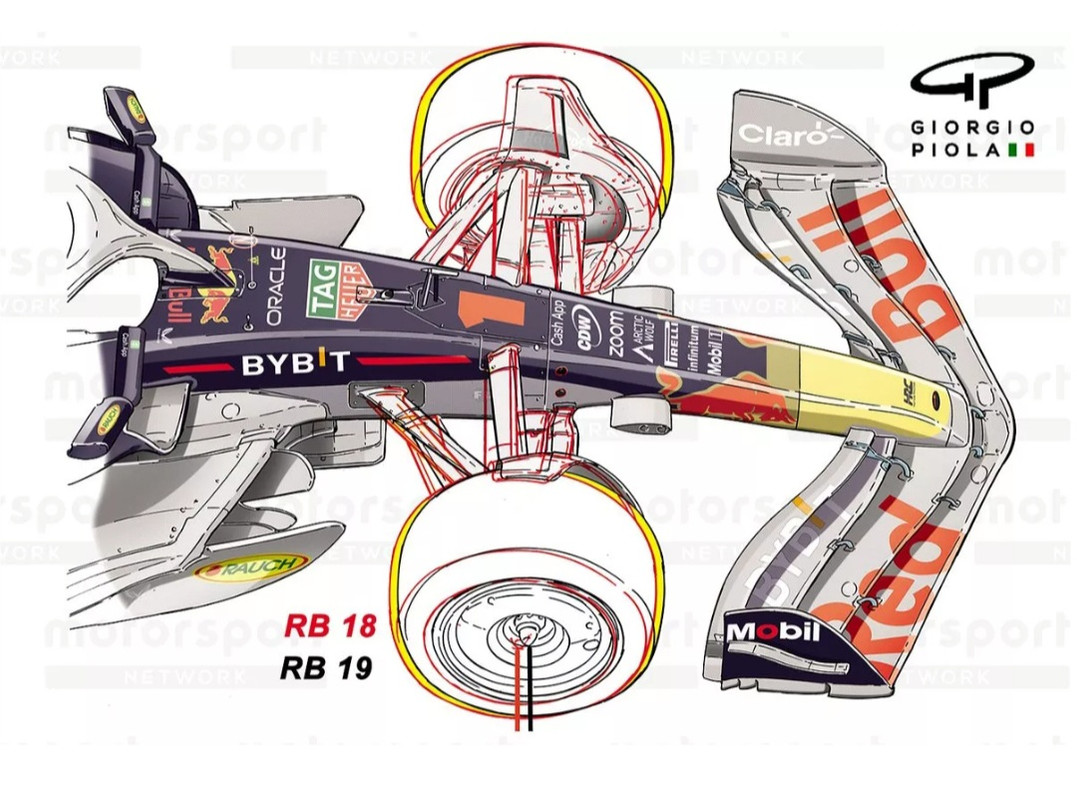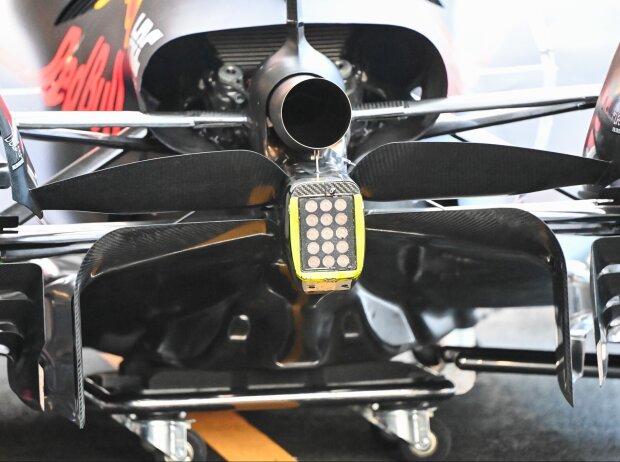I am glad to disagree.
Out of context.
I am glad to disagree.

I think lower spring rate and high rebound damping would be useful characteristics at low ride heights, perhaps that’s what it does.
The preload spring link is what we determined it to be last year, this wouldn’t work in a conventional suspension system. However, because the ARB is SO BIG it can work; the rear axle behaves like a beam axle.henry wrote: ↑26 Mar 2023, 10:45I think lower spring rate and high rebound damping would be useful characteristics at low ride heights, perhaps that’s what it does.
In my mind I think it might form a non rigid anchor for the “fixed” end of the torsion bars.
It could have a preload that determines at what load the suspension should become less stiff, and a spring rate that combines with the stiffness of the torsion bars to provide a lower rate beyond the preload point. Two springs in series have a lower rate than either individually.
It might also provide asymmetric damping in this deflection region. A high rebound damping, combined with lower return force, would help to control the onset of porpoising. Highly asymmetric damping is restricted in the regulations, but when has that ever stopped F1 engineers.
Just a guess.
Thanks, and apologies for missing this first time round.Stu wrote: ↑26 Mar 2023, 11:07The preload spring link is what we determined it to be last year, this wouldn’t work in a conventional suspension system. However, because the ARB is SO BIG it can work; the rear axle behaves like a beam axle.henry wrote: ↑26 Mar 2023, 10:45I think lower spring rate and high rebound damping would be useful characteristics at low ride heights, perhaps that’s what it does.
In my mind I think it might form a non rigid anchor for the “fixed” end of the torsion bars.
It could have a preload that determines at what load the suspension should become less stiff, and a spring rate that combines with the stiffness of the torsion bars to provide a lower rate beyond the preload point. Two springs in series have a lower rate than either individually.
It might also provide asymmetric damping in this deflection region. A high rebound damping, combined with lower return force, would help to control the onset of porpoising. Highly asymmetric damping is restricted in the regulations, but when has that ever stopped F1 engineers.
Just a guess.
They are using Multimatic damper units, suggested within their advertising to be using SSV valving.
Interesting theory of his but I have doubts about it.aleallievi wrote: ↑26 Mar 2023, 11:03Very interesting theory by this Italian YouTuber. It seems that the rear suspension’s top wishbone could be dynamically adjusted under (rear wing) load thanks to a clever sliding mechanism. This could change the camber and caster angle at high vs low speeds.

+1 The wording of that section of the regs is lengthy.henry wrote: ↑26 Mar 2023, 10:45In my mind I think it might form a non rigid anchor for the “fixed” end of the torsion bars.
It could have a preload that determines at what load the suspension should become less stiff, and a spring rate that combines with the stiffness of the torsion bars to provide a lower rate beyond the preload point. Two springs in series have a lower rate than either individually.
It might also provide asymmetric damping in this deflection region. A high rebound damping, combined with lower return force, would help to control the onset of porpoising. Highly asymmetric damping is restricted in the regulations, but when has that ever stopped F1 engineers.
You're saying it might have a spring rate itself, or it's a rigid link?Stu wrote: ↑26 Mar 2023, 11:07The preload spring link is what we determined it to be last year, this wouldn’t work in a conventional suspension system. However, because the ARB is SO BIG it can work; the rear axle behaves like a beam axle.
They are using Multimatic damper units, suggested within their advertising to be using SSV valving.
Same, I missed out on some sections last year. In my many discussions with hollus about the contours of apolitical speech on the website, he would often reply with, "Ban." I digress. Your mention of roll loads makes me think about how 5 g lateral must impose relatively large demands upon an anti-roll system. Can anyone comment on this, what must be a unique value for F1?henry wrote: ↑26 Mar 2023, 12:42Thanks, and apologies for missing this first time round.
So the ARB behaves more as a stiff link than a deformable roll bar? I would expect a need to also have this feature dependant on vertical load, stiff at high loads and soft at low, perhaps even redundant, relying on the roll damper installation for anti roll functionality at low loads. Otherwise your swing is great but your roundabout is not very comfortable.
+1 I also would not expect any significant deflection from this structure. Beautiful machined piece though. 95% of that block turned into swarf. And it supports upward of 500kg(?).AR3-GP wrote: ↑26 Mar 2023, 16:11Interesting theory of his but I have doubts about it.aleallievi wrote: ↑26 Mar 2023, 11:03Very interesting theory by this Italian YouTuber. It seems that the rear suspension’s top wishbone could be dynamically adjusted under (rear wing) load thanks to a clever sliding mechanism. This could change the camber and caster angle at high vs low speeds.
https://youtu .be/mmkhiOW8wDU
It would violate some of the regulations surrounding moveable aero in addition to some un-physical/non-existent degrees of freedom that the author claims are present.
Here's a picture of last year's Alpha Tauri which has very similar detail, but you can see that the "pins" at the back are more likely to be a locating feature. The cradle itself is rigidly mounted to the top of the gearbox carrier (and since AT and Rb are sharing this...). For many reasons including the rigidity requirements of a structure like this and the picture below (*of the AT), I doubt this structure is "sliding".
https://i.postimg.cc/xC6H6zSk/image.png

As @Henry suggests rather than a solid link (which I had originally thought it may be - for ride height adjustments), I believe that it contains a heavily preloaded spring, so that at a given vertical load you get a drop in ride height.vorticism wrote: ↑26 Mar 2023, 16:25+1 The wording of that section of the regs is lengthy.henry wrote: ↑26 Mar 2023, 10:45In my mind I think it might form a non rigid anchor for the “fixed” end of the torsion bars.
It could have a preload that determines at what load the suspension should become less stiff, and a spring rate that combines with the stiffness of the torsion bars to provide a lower rate beyond the preload point. Two springs in series have a lower rate than either individually.
…
It looked so simple, as a device, that I was at that time thinking it may simply be a turnbuckle; to what end though? Would be a convoluted way to adjust ride height f.e. when you can do the same with more accessible shims or turnbuckles on the pushrod.
You're saying it might have a spring rate itself, or it's a rigid link?Stu wrote: ↑26 Mar 2023, 11:07The preload spring link is what we determined it to be last year, this wouldn’t work in a conventional suspension system. However, because the ARB is SO BIG it can work; the rear axle behaves like a beam axle.
They are using Multimatic damper units, suggested within their advertising to be using SSV valving.
… Your mention of roll loads makes me think about how 5 g lateral must impose relatively large demands upon an anti-roll system. Can anyone comment on this, what must be a unique value for F1?henry wrote: ↑26 Mar 2023, 12:42Thanks, and apologies for missing this first time round.
So the ARB behaves more as a stiff link than a deformable roll bar? I would expect a need to also have this feature dependant on vertical load, stiff at high loads and soft at low, perhaps even redundant, relying on the roll damper installation for anti roll functionality at low loads. Otherwise your swing is great but your roundabout is not very comfortable.